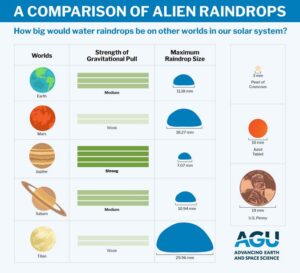Do you ever wonder how rain is on other planets from our Solar System? But how about on potentially habitable planets? According to a new study, raindrops can help us identify other planets outside our Solar System.
For the new paper, a team of Harvard researchers made quite the discovery: rain is the same even on planets with harsh environments. A better understanding of how raindrops really are on other planets can reveal more data about the ancient climate on Mars, for instance. And that’s not all.
Here is what you need to know.
The Theory of Raindrops
The team of researchers identified a hot spot for raindrop size using only three features: drop shape, falling velocity, and evaporation speed. The results are genuinely intriguing.
Shape
Drop shapes depend on how heavy the drop is. They’re similar across various rain materials, too.Â
The traditional tear-shaped droplet is, in fact, just our imagination. In reality, raindrops are spherical at first. Later they turn bigger until they reach a shape more like the top of a hamburger bun (how cool is this?)
Speed
The falling speed depends mainly on the raindrop shape and, of course, on gravity. Thickness is also a significant factor.
As for the evaporation speed, things are a bit complicated. According to scientists, this is driven by temperature, relative humidity, atmospheric composition, pressure, and more.Â
So, how all these features can help us find out other potentially habitable planets? How did the team reach such an approach?
Below, you can see a useful graphic of how rain behaves on other planets:

The findings
By using the three properties, the team discovered that things look pretty intriguing across a broad range of planetary conditions.
The “equation of raindrop falling” indicates that just a little bit of the possible drop sizes in a cloud can end up on the ground. This behaviour can help us model cloud cycles on exoplanets.
Robin Wordsworth is part of the team and an Associate Professor of Environmental Science and Engineering at the SEAS. He explains:
“If we understand how individual raindrops behave, we can better represent rainfall in complex climate models.”
Let’s hope the rain will guide us through space and time and help us discover other worlds!












Leave a Reply